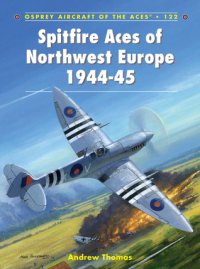
Ebook: Spitfire Aces of Northwest Europe 1944-45
Author: Andrew Thomas, Chris Thomas(Illustrations)
- Tags: Aviation, World War 2, 20th Century
- Series: Aircraft of the Aces 122
- Year: 2014
- Publisher: Osprey Publishing
- Language: English
- pdf
Spitfire Aces of Northwest Europe details the exploits of the 37 pilots that "made ace" flying Merlin-enguned Spitfires in bitter aerial clashes over northwest Eurpose in the final years of World War II.
After seizing air superiority over France before D-Day, the Spitfire battled Luftwaffe fighters over the V-2 rocket sites and Nazi Germany itself.
The iconic Spitfire underwent steady development throughout its service life, and by the start of 1944 it was the RAF's most numerous day fighter, equipping dozens of squadrons in the newly formed 2nd TAF and the Air Defense of Great Britain. Squadrons of both commands were heavily involved in the "softening" of tactical targets in France before D-Day, not only with fighter-bomber attacks but also escorting Allied medium bomber raids. Although the Griffon-engined Spitfire was entering service, it was the Merlin-engined variants (models V, IX and XVI) that predominated through to the end of the war. Based at airfields throughout southern England, the Merlin Spitfire squadrons provided the bulk of the air cover for the D-Day landings. Shortly afterwards, most 2nd TAF squadrons moved the Continent to be initially based on hastily leveled strips. As the Luftwaffe attempted to counter Allied air superiority, a large number of pilots flying Merlin Spitfires built substantial scores as they followed the Allied armies across Northwest Europe - it was RCAF Merlin Spitfires that claimed the first Me 262 jet to be shot down.
As the Allied forces entered Germany, the Spitfire units were often engaged by the Luftwaffe in savage air combat over the shrinking Third Reich. These encounters resulted in high scores for the Allied fighter units. The Merlin Spitfire squadrons from the RAF, RAAF, RCAF, RNZAF and "Free European" squadrons also flew an increasing number of ground attack sorties during the last months of the war. The 2nd TAF squadrons were formed into mobile wings, many of which were commanded or led in the air by some of the most successful RAF Spitfire aces, and many others would also command squadrons.
This volume also covers the exploits of those Merlin Spitfire squadrons that remained under ADGB control, which were employed on long-range escort for the RAF's daylight heavy bomber raids against German industry. Several squadrons were also involved in the anti-V1 Operation "Diver" campaign, and the targeting of V2 rocket launch sites (Operation "Big Ben").
After seizing air superiority over France before D-Day, the Spitfire battled Luftwaffe fighters over the V-2 rocket sites and Nazi Germany itself.
The iconic Spitfire underwent steady development throughout its service life, and by the start of 1944 it was the RAF's most numerous day fighter, equipping dozens of squadrons in the newly formed 2nd TAF and the Air Defense of Great Britain. Squadrons of both commands were heavily involved in the "softening" of tactical targets in France before D-Day, not only with fighter-bomber attacks but also escorting Allied medium bomber raids. Although the Griffon-engined Spitfire was entering service, it was the Merlin-engined variants (models V, IX and XVI) that predominated through to the end of the war. Based at airfields throughout southern England, the Merlin Spitfire squadrons provided the bulk of the air cover for the D-Day landings. Shortly afterwards, most 2nd TAF squadrons moved the Continent to be initially based on hastily leveled strips. As the Luftwaffe attempted to counter Allied air superiority, a large number of pilots flying Merlin Spitfires built substantial scores as they followed the Allied armies across Northwest Europe - it was RCAF Merlin Spitfires that claimed the first Me 262 jet to be shot down.
As the Allied forces entered Germany, the Spitfire units were often engaged by the Luftwaffe in savage air combat over the shrinking Third Reich. These encounters resulted in high scores for the Allied fighter units. The Merlin Spitfire squadrons from the RAF, RAAF, RCAF, RNZAF and "Free European" squadrons also flew an increasing number of ground attack sorties during the last months of the war. The 2nd TAF squadrons were formed into mobile wings, many of which were commanded or led in the air by some of the most successful RAF Spitfire aces, and many others would also command squadrons.
This volume also covers the exploits of those Merlin Spitfire squadrons that remained under ADGB control, which were employed on long-range escort for the RAF's daylight heavy bomber raids against German industry. Several squadrons were also involved in the anti-V1 Operation "Diver" campaign, and the targeting of V2 rocket launch sites (Operation "Big Ben").
Download the book Spitfire Aces of Northwest Europe 1944-45 for free or read online
Continue reading on any device:

Last viewed books
Related books
{related-news}
Comments (0)